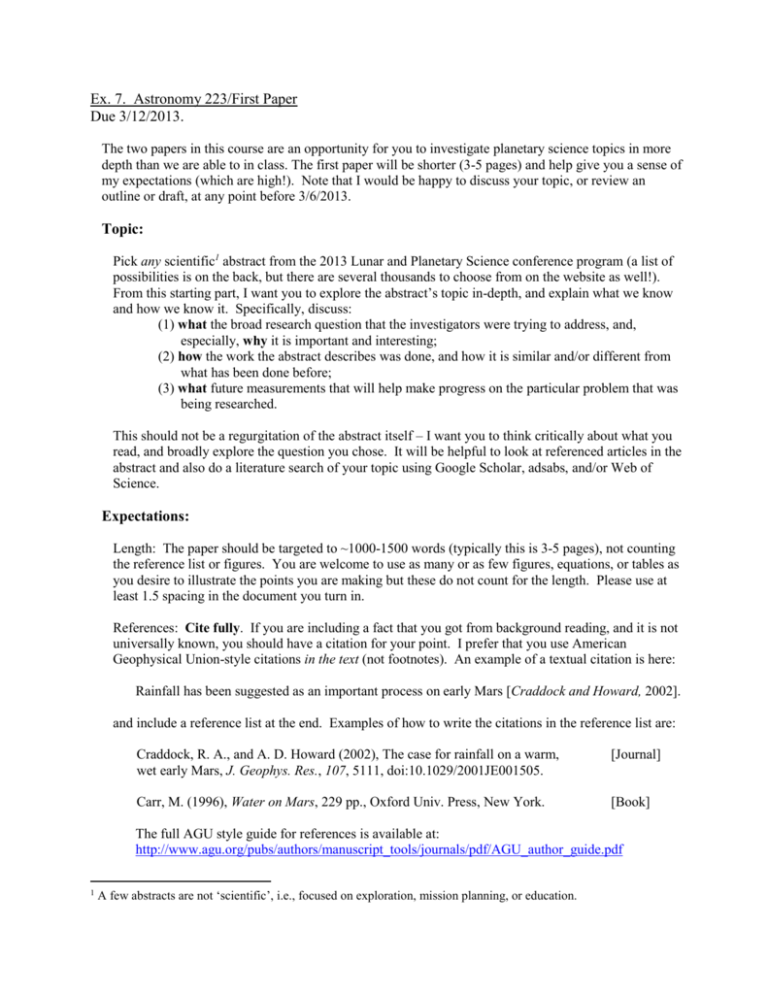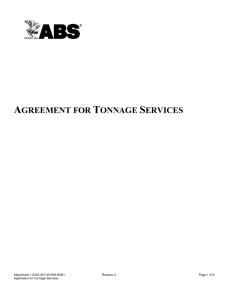First Paper
advertisement

Ex. 7. Astronomy 223/First Paper Due 3/12/2013. The two papers in this course are an opportunity for you to investigate planetary science topics in more depth than we are able to in class. The first paper will be shorter (3-5 pages) and help give you a sense of my expectations (which are high!). Note that I would be happy to discuss your topic, or review an outline or draft, at any point before 3/6/2013. Topic: Pick any scientific1 abstract from the 2013 Lunar and Planetary Science conference program (a list of possibilities is on the back, but there are several thousands to choose from on the website as well!). From this starting part, I want you to explore the abstract’s topic in-depth, and explain what we know and how we know it. Specifically, discuss: (1) what the broad research question that the investigators were trying to address, and, especially, why it is important and interesting; (2) how the work the abstract describes was done, and how it is similar and/or different from what has been done before; (3) what future measurements that will help make progress on the particular problem that was being researched. This should not be a regurgitation of the abstract itself – I want you to think critically about what you read, and broadly explore the question you chose. It will be helpful to look at referenced articles in the abstract and also do a literature search of your topic using Google Scholar, adsabs, and/or Web of Science. Expectations: Length: The paper should be targeted to ~1000-1500 words (typically this is 3-5 pages), not counting the reference list or figures. You are welcome to use as many or as few figures, equations, or tables as you desire to illustrate the points you are making but these do not count for the length. Please use at least 1.5 spacing in the document you turn in. References: Cite fully. If you are including a fact that you got from background reading, and it is not universally known, you should have a citation for your point. I prefer that you use American Geophysical Union-style citations in the text (not footnotes). An example of a textual citation is here: Rainfall has been suggested as an important process on early Mars [Craddock and Howard, 2002]. and include a reference list at the end. Examples of how to write the citations in the reference list are: Craddock, R. A., and A. D. Howard (2002), The case for rainfall on a warm, wet early Mars, J. Geophys. Res., 107, 5111, doi:10.1029/2001JE001505. [Journal] Carr, M. (1996), Water on Mars, 229 pp., Oxford Univ. Press, New York. [Book] The full AGU style guide for references is available at: http://www.agu.org/pubs/authors/manuscript_tools/journals/pdf/AGU_author_guide.pdf 1 A few abstracts are not ‘scientific’, i.e., focused on exploration, mission planning, or education. Some Potential Topics: Mercury: Imaging inside Mercury’s permanently shadowed craters: first images from MESSENGER. Chabot, N.L. et al., abs. no. 1693. The Moon: Crater Statistics of Lunar Mare: Using crater size-frequency measurements to distinguish age units with volcanic smooth plains – a new approach. Ostrach, L.R. and M.S. Robinson, abs. no. 1086. Lunar Bulk Composition: Revised thickness of the lunar crust from GRAIL data: Implications for bulk composition. Taylor, G.J. et al., abstract no. 1783. Sample Ages: What lunar zircons age can tell? Grange, M.L. et al., abs. no. 1884. Mars: Implications of a bomb sag on Mars from MER Spirit: Constraints on surface conditions and atmospheric density inferred from the bomb age at Home Plate, Mars. Manga, M. et al., abs. no. 1109. Weird spherules from MSL: A preliminary assessment of sub-mm spherules at Rocknest, Gale Crater Mars. Yingst, R.A. et al., abs. no. 1257. Organic molecules on Mars from MSL: Investigating the origin of chlorohydrocarbons detected by the Sample Analysis at Mars (SAM) instrument at Rocknest. Glavin, D. et al., abs. no. 1080. Methane on Mars from MSL: Measurements of Mars methane at Gale Crater by the SAM Tunable Laser Spectrometer on the Curiosity Rover. Webster, C.R. et al., abs. no. 1366. Water, water everywhere, but not a drop to drink: The history of water on early Mars: the Sun, the wind, and the rain. Craddock, R.A. et al. abs. no. 1984. Satellites: Enceladus: Forming CO2 Ice on Enceladus’ Surface. Matson, D.L. et al., abs. no. 1373. Titan: Exploring the inner structure of Titan’s dunes: implications for understanding paleo-wind regimes. Sharma, P. et al.,abs. no. 1821 Titan: Morphologic analysis of polar landscape evolution on Titan. Hayes, A.G. et al., abs. no. 2000. Phobos and Deimos: Internal characteristics of Phobos and Deimso from spectral properties and density: Relationships to landforms and comparison with asteroids. Murchie, S.L. et al., abs. no. 1604. Planet Formation: On building an Earth-like planet. Elkins-Tanton, L.T., abs. no. 1408. On the origin and evolution of differentiated planetesimals. Bottke, W.F. & Asphaug, E. abs. no 1672.









